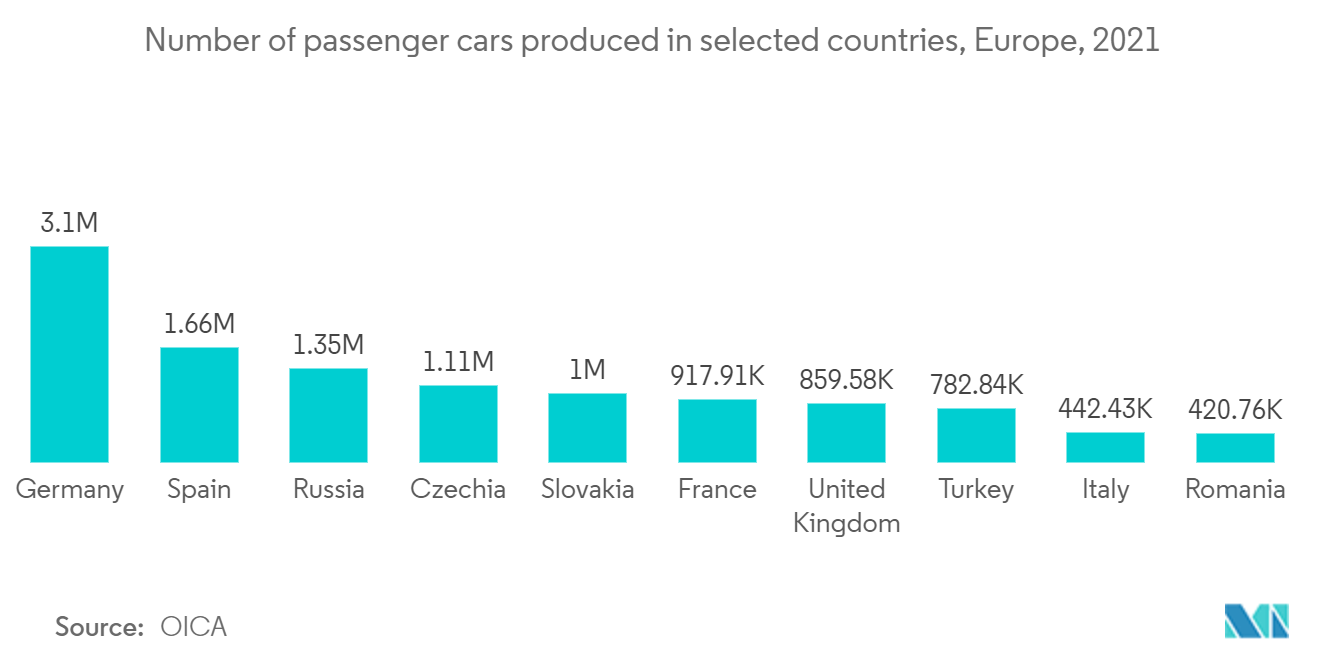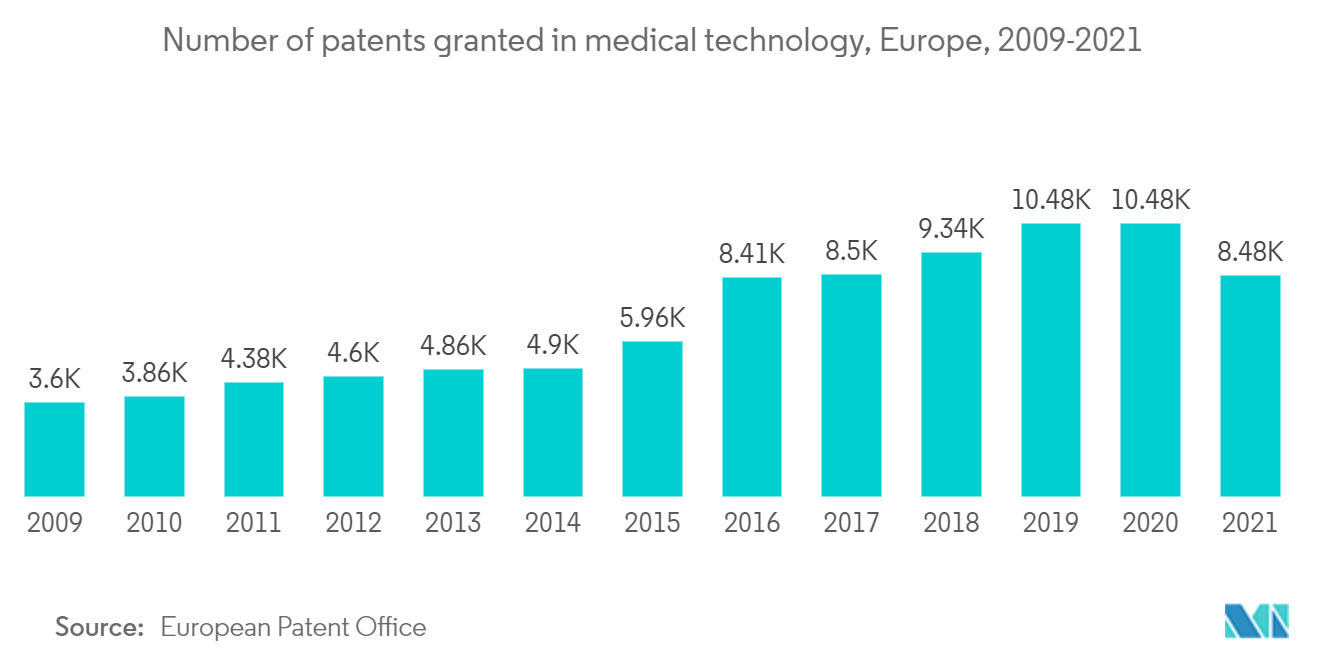Market Trends of Europe Image Sensors Industry
This section covers the major market trends shaping the Europe Image Sensors Market according to our research experts:
The Automotive Segment is Expected to Drive the Market's Growth
- Image sensors for automotive applications are an essential feature for car safety. Beyond the sensing and viewing applications of traditional rear-view cameras, the demand for all-around interior and exterior monitoring and viewing capabilities has become an unequivocal necessity. Through the development and implementation of Advanced Driver Assistance Systems (ADAS) and Driver Monitoring Systems (DMS), cars have become and will continue to progress in safety and reliability, not only to alert drivers to potential incidents but to intervene as well. This is driving the growth of the studied market.
- According to OICA (International Organization of Motor Vehicle Manufacturers), Germany made the most passenger automobiles in Europe in 2021. In that year, it produced about 3.1 million passenger cars. With over 1.7 million passenger automobiles produced, Spain came in second. Furthermore, more than 16.3 million vehicles were produced in the European automotive sector in 2021, with passenger cars making up about 85% of the total. Such huge production of cars will create an opportunity for the local vendors to expand their product portfolio according to the requirements of the clients and capture a wide market share.
- Seamless connectivity with new services, innovative car cockpits, and improved passive safety: 3D depth sensors play a vital role in monitoring systems in the vehicle cabin. They are essential to meet regulations and NCAP ratings. They are also vital to realize the vision of the driver becoming a passenger.
- To that end, in June 2022, Infineon Technologies AG, in partnership with 3D time-of-flight system specialist pmd technologies ag, developed the second generation of the REAL3 automotive image sensor - an ISO26262-compliant high-resolution 3D image sensor. The sensor is encased in a 9 x 9 mm² plastic BGA package and offers a VGA system resolution of 640 x 480 pixels with a tiny image circle of 4 mm. It allows lens sizes like those known from smartphones to automotive applications. The high resolution of the REAL3 sensor makes it appropriate for camera applications with a wide field of view, like complete front-row occupant monitoring systems. The resulting 3D body models enable accurate estimates of occupant size and weight and highly precise passenger and seat position data, which is key information for intelligent airbag deployment and restraint systems. Besides safety-critical applications, the 3D data facilitates comfort features like gesture control or intuitive interior lighting that follows passengers' movements.
- The region is also witnessing an upsurge in the innovation of new and comprehensive products and solutions. In May 2022, STMicroelectronics developed a global-shutter image sensor for driver monitoring systems (DMSs). They constantly watch the driver's head movements to recognize signs of drowsiness and distraction, enabling systems in the vehicle to generate warnings that can preserve the safety of occupants. The global-shutter sensor, the VB56G4A, leverages ST's in-house investment in manufacturing advanced 3D-stacked back-side illuminated (BSI-3D) image sensors. These are more sensitive, smaller, and reliable than conventional front-side illuminated (FSI) sensors typically used in first-generation DMSs.
- In July 2021, Samsung launched its new ISOCELL Auto 4AC, its first image sensor, tailor-made for cars. It is intended to be utilized as a reverse camera or (on more advanced systems) to power surround view monitors. The technology integrates two photodiodes per pixel - one 3.0 µm for low-light operation and one 1.0 µm placed in the corner that will be used for bright environments. This setup enables the sensor to quickly adjust to changes in the surrounding light, ex: when exiting a tunnel. It also offers a high dynamic range with little motion blur and reduces the flicker of LED lights.

The Healthcare Sector is Expected to Hold a Significant Market Share
- Imaging sensors have applications in various medical sectors like dental imaging, Digital Mammography, Ophthalmology, X-Ray image reconstruction, Endoscopy, and digital pathology, Orthopedic and surgical procedures. High resolution, fast frame rate, high NIR sensitivity, excellent image quality, and medically qualified imager sensors are the key improvements that help to advance the technique. Several regional companies are developing innovative products, including reliable, accurate, and high-performance vision and camera sensors, to improve image efficiency and accuracy and meet the medical and life sciences sector's ever-demanding requirements.
- For instance, in June 2021, OmniVision Technologies, Inc., a provider of advanced digital imaging solutions, announced its next-generation OH08A and OH08B CMOS image sensors, the first 8 megapixels (MP) resolution sensors for single-use and reusable endoscopes. Additionally, the new OH08B is the first medical-grade image sensor to use OmniVision's Nyxelnear-infrared (NIR) technology, bringing revolutionary imaging capabilities beyond the visible spectrum to the medical industry. Additionally, the OH08B is the first medical-grade image sensor to use OmniVision's Nyxelnear-infrared (NIR) technology, bringing advanced imaging capabilities beyond the visible spectrum to the medical industry.
- Further, in November 2021, OMNIVISION Technologies, Inc., and Diaspective Vision GmbH, developer of high-quality hyperspectral and multispectral camera systems for medical applications, announced their partnership in developing a new type of endoscopic camera, the MALYNA system, based on proprietary multispectral imaging technology. According to Diaspective Vision, the fifth dimension of medical imaging, the MALYNA is set to become a standard diagnostics tool like ultrasound, MRI, and CT scans as it provides live imaging in addition to hyperspectral and multispectral imaging, which shows the different perfusion parameters and risk structures of the tissue, and ICG imaging for cancer detection. This combination of different imaging procedures maximizes productivity during endoscopy. The image sensor is suitable to be utilized in gastroscopes, duodenoscopes, amnioscopes, laparoscopes and colonoscopes.
- Further, in place of amorphous silicon flat panels, CMOS image sensors are now often employed for medical X-Ray imaging. Since there is no lens required for CMOS-based X-ray applications, the image sensor's size must coincide with the size of the target region.
- In March 2021, the development of the new "Built-in AEC1 assistance" technology for digital radiography (DR)2 was announced by Canon Inc. With this technique, the X-ray image sensor of the device makes use of similar parts that can do both picture production and real-time detection of the pixel value3 corresponding to emitted X-rays, alerting the X-ray generator when the pixel value reaches a predetermined value. Canon has developed its new "Built-in AEC Assistance" technology by utilizing the image and X-ray sensor technologies the business has developed over its long history in order to enhance such standard operations. With the enable of modern technologies, imaging equipment now has built-in capabilities that formerly required separate devices.

